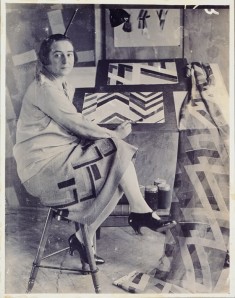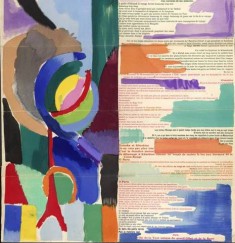| Sonia Delaunay | |
|---|---|
 |
|
| Born | Sarah Ilinitchna Stern Nov. 14, 1885 Russian Empire |
| Died | Dec. 5, 1979 (at age 94) Paris, France |
| Nationality | Russian, French |
| Movement | Orphism |
| Field | Painting |
| Works | |
Born Sarah Ilinitchna Terk, Sonia Delaunay was a European artist who helped create the idea of Orphism in art. She was born in the Ukraine in 1885 to a poor family. She was adopted by her mother’s brother who was a wealthy Jewish lawyer. This is when she took the name Sonia Terk.
Unlike her biological parents, the Terks had the resources to travel around Europe and introduce her to art galleries and museums. She went to an art school in Germany after she graduated high school at age 18 because a teacher remarked on her talent. She later made Paris her home.
Sonia Delaunay in Paris
A few years later, Delaunay moved to Paris after reading that it was the center of the true art world. The community was vibrant and her work was vastly influenced by the galleries and museums in the city. She also took inspiration from some of the artists she met. She did, however, struggle with academics during her time there.
While in Paris, Delaunay married a gallery owner Wilhelm Uhde in 1908 in what is now widely believed to be a marriage of convenience. Her family was traditional and unappreciative of her career as an artist while Wilhelm was a homosexual. She had to conform to her parents’ traditional values and he wanted to hide his sexuality.
She met her next husband, Robert Delaunay, in the gallery. They became lovers and she unexpectedly became pregnant. Uhde and Sonia divorced and she married Delaunay in November of 1910. Their son, Charles, was born a couple months later on January 18th.
Sonia Returns to Paris
 Sonia was interested in the idea of color juxtaposition, an idea which was later reflected in her work. After her family fled to Portugal to escape World War I, she opened a design house called Casa Sonia. Although it was very successful, she returned to Paris in the 1920s.
Sonia was interested in the idea of color juxtaposition, an idea which was later reflected in her work. After her family fled to Portugal to escape World War I, she opened a design house called Casa Sonia. Although it was very successful, she returned to Paris in the 1920s.
The family had money problems, but Sonia seemed to become successful in the fashion world easily. She launched more than one collection which was extremely successful and her clothes were frequently photographed. Her work was part of the female independence movement, giving a certain amount of empowerment to women.
Sonia designed more than clothes. She also designed handbags, scarves, and accessories. She also made costumes for two films in the 1920s: Vestige and Le p’tit Parigot. In 1927, Delaunay introduced the idea of “ready-to-wear,” which was revolutionary at the time but remains an important part of daily life today.
Sonia’s Return to Painting
Delaunay had been outstandingly successful in the fashion world, but in the art world she remained overshadowed by her husband. She started to paint again in the 1930s, but she only received worldwide acclaim as an artist several decades later. Her husband died of cancer in 1941.
By all accounts, Sonia was the family’s provider and her work as a fashion designer had enabled her to look after both her husband and her child. She survived her husband for nearly 40 years, all the while overseeing her husband’s legacy.
The Delaunay Legacy
The approach that Sonia had to her work has resonated with artists over the past century. In her own words, Delaunay never believed that fashion was not an extension – or as important a part – of her art. She was a huge part of the desire to eradicate the distinctions between life and art.
Delaunay worked very hard to preserve her husband’s legacy without ever giving up on her own art. She was part of the Orphism movement, which places particular emphasis on color as the primary means to artistic expression. Sonia’s work had an influence on the movement which would become Art Deco. She was also the first living woman to be given a retrospective at the Louvre.
Sonia Delaunay’s work is a huge part of modernism and the effect of the work she did with colors is seen in fashion and architecture even today. Some of her revolutionary ideas, like ready-to-wear clothes, have caught on and are now part of everyday life. Sonia Delaunay impacted the world with her ideas on fashion and art. She died a wealthy woman that had been a huge influence on the world at the age of 94 in Paris.